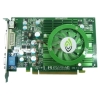How Graphics Cards Work
by Tracy V. Wilson and Jeff Tyson
Browse the article How Graphics Cards Work
Introduction to How Graphics Cards Work
The images you see on your monitor are made of tiny dots called pixels. At most common resolution settings, a screen displays over a million pixels, and the computer has to decide what to do with every one in order to create an image. To do this, it needs a translator -- something to take binary data from the CPU and turn it into a picture you can see. Unless a computer has graphics capability built into the motherboard, that translation takes place on the graphics card. A graphics card's job is complex, but its principles and components are easy to understand. In this article, we will look at the basic parts of a video card and what they do. We'll also examine the factors that work together to make a fast, efficient graphics card.
 The graphics card creates a wire frame image, then fills it in and adds textures and shading. |
Graphics Card Basics
Think of a computer as a company with its own art department. When people in the company want a piece of artwork, they send a request to the art department. The art department decides how to create the image and then puts it on paper. The end result is that someone's idea becomes an actual, viewable picture.
 Photo courtesy of HowStuffWorks Shopper The four main components of a graphics card are connections for the motherboard and monitor, a processor, and memory. |
| |
The graphics card accomplishes this task using four main components:
- A motherboard connection for data and power
- A processor to decide what to do with each pixel on the screen
- Memory to hold information about each pixel and to temporarily store completed pictures
- A monitor connection so you can see the final result
Processor and Memory
Like a motherboard, a graphics card is a printed circuit board that houses a processor and RAM. It also has an input/output system (BIOS) chip, which stores the card's settings and performs diagnostics on the memory, input and output at startup. A graphics card's processor, called a graphics processing unit (GPU), is similar to a computer's CPU. A GPU, however, is designed specifically for performing the complex mathematical and geometric calculations that are necessary for graphics rendering. Some of the fastest GPUs have more transistors than the average CPU. A GPU produces a lot of heat, so it is usually located under a heat sink or a fan.  Photo courtesy of HowStuffWorks Shopper A heat sink or fan keeps a graphics card's processor from overheating. |
- Full scene anti aliasing (FSAA), which smoothes the edges of 3-D objects
- Anisotropic filtering (AF), which makes images look crisper
| |
As the GPU creates images, it needs somewhere to hold information and completed pictures. It uses the card's RAM for this purpose, storing data about each pixel, its color and its location on the screen. Part of the RAM can also act as a frame buffer, meaning that it holds completed images until it is time to display them. Typically, video RAM operates at very high speeds and is dual ported, meaning that the system can read from it and write to it at the same time.
The RAM connects directly to the digital-to-analog converter, called the DAC. This converter, also called the RAMDAC, translates the image into an analog signal that the monitor can use. Some cards have multiple RAMDACs, which can improve performance and support more than one monitor. You can learn more about this process in How Analog and Digital Recording Works.
The RAMDAC sends the final picture to the monitor through a cable. We'll look at this connection and other interfaces in the next section.
Input and Output
| |
- Peripheral component interconnect (PCI)
- Advanced graphics port (AGP)
- PCI Express (PCIe)
Most people use only one of their two monitor connections. People who need to use two monitors can purchase a graphics card with dual head capability, which splits the display between the two screens. A computer with two dual head, PCIe-enabled video cards could theoretically support four monitors.
 Photo courtesy of HowStuffWorks Shopper This Radeon X800XL graphics card has DVI, VGA and ViVo connections. |
- TV display: TV-out or S-video
- Analog video cameras: ViVo or video in/video out
- Digital cameras: FireWire or USB
| |
Choosing a Good Graphics Card
A top-of-the-line graphics card is easy to spot. It has lots of memory and a fast processor. Often, it's also more visually appealing than anything else that's intended to go inside a computer's case. Lots of high-performance video cards are illustrated or have decorative fans or heat sinks. But a high-end card provides more power than most people really need. People who use their computers primarily for e-mail, word processing or Web surfing can find all the necessary graphics support on a motherboard with integrated graphics. A mid-range card is sufficient for most casual gamers. People who need the power of a high-end card include gaming enthusiasts and people who do lots of 3-D graphic work.  Photo courtesy of HowStuffWorks Shopper Some cards, like the ATI All-in-Wonder, include connections for televisions and video as well as a TV tuner. |
- Triangles or vertices per second: 3-D images are made of triangles, or polygons. This measurement describes how quickly the GPU can calculate the whole polygon or the vertices that define it. In general, it describes how quickly the card builds a wire frame image.
- Pixel fill rate: This measurement describes how many pixels the GPU can process in a second, which translates to how quickly it can rasterize the image.
- GPU clock speed (MHz)
- Size of the memory bus (bits)
- Amount of available memory (MB)
- Memory clock rate (MHz)
- Memory bandwidth (GB/s)
- RAMDAC speed (MHz)














